 The German-speaking Saxons were invited to Transylvania, to the easternmost borders of Hungary by the first Hungarian kings. They preserved their special culture and enjoyed several privileges within the Hungarian kingdom. Although the first printing press of Transylvanian Saxons was set up in Szeben (Hermannstadt, Sibiu, R), it soon ceased its activity, and it was the printing shop of Johannes Honterus in Brassó the activity of which remained continuous until almost the end of the XVIth century. Honterus was a prominent figure of the cultural and religious life of Brassó, the leading Lutheran priest, school-master and printer of his native town. He began printing after attending the universities of Vienna and Cracow, and after taking an active part in Basle book production: his craft as a wood-cutter was well-known in Basle in the circle of prominent publishers and printers.
The German-speaking Saxons were invited to Transylvania, to the easternmost borders of Hungary by the first Hungarian kings. They preserved their special culture and enjoyed several privileges within the Hungarian kingdom. Although the first printing press of Transylvanian Saxons was set up in Szeben (Hermannstadt, Sibiu, R), it soon ceased its activity, and it was the printing shop of Johannes Honterus in Brassó the activity of which remained continuous until almost the end of the XVIth century. Honterus was a prominent figure of the cultural and religious life of Brassó, the leading Lutheran priest, school-master and printer of his native town. He began printing after attending the universities of Vienna and Cracow, and after taking an active part in Basle book production: his craft as a wood-cutter was well-known in Basle in the circle of prominent publishers and printers.
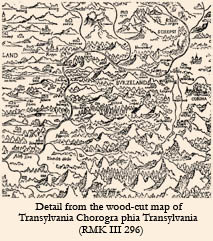 It was in Basle that he drew and cut his two large heaven maps on the commitment of the publisher Heinrich Petri as well as his famous Chorographia Transylvania map, his outstanding achievement as a geograph (RMK III 296), although the copies known to us were printed after returning to Brassó, to Transylvania (1539).
It was in Basle that he drew and cut his two large heaven maps on the commitment of the publisher Heinrich Petri as well as his famous Chorographia Transylvania map, his outstanding achievement as a geograph (RMK III 296), although the copies known to us were printed after returning to Brassó, to Transylvania (1539).
As a many-sided humanist he apparently recognized the importance of printing, and after returning to Brassó, he set up a printing shop in his own house and in 1539 he began to issue books from antique authors and text books in Latin and Greek. 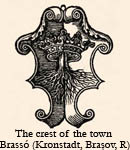 The majority of his books bear his printer's device being at the same time the crest of the town Brassó (Corona in Latin): the roots of a tree with a crown.
The majority of his books bear his printer's device being at the same time the crest of the town Brassó (Corona in Latin): the roots of a tree with a crown.
The books that his press issued fitted into his educational programme. They are in octavo format and printed almost exclusively with Italics. Both their format and printing type suggest that the great Venetial printer Aldus Manutius had a decisive effect on Honterus' taste as a printer-publisher.
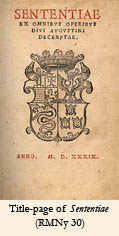 |
 |
His German language publications, on the other hand, served his activity as a priest and a reformer of the church. They helped Honterus to organize the Lutheran church not only in Brassó but in the whole German-speaking part of Transylvania. Martin Luthers minor catechism was repeatedly issued by him.
In his life-time 36 publications have left his printing press. In these one can trace the first wood-cuts produced in Hungary, which were very likely all his works. After his death the printing shop was taken over by Valentin Wagner, a priest and school-master himself, who studied at Wittenberg, and continued the activity of the press in the spirit of Honterus. The most important work he produced was the Greek-Latin Novum Testamentum, 1557 (RMNy 138). He also acquired a five-year exclusive privilege for it from the Hungarian King and Transylvanian Prince János Zsigmond.
After Wagner's death the activity of the printing shop founded by Honterus was not continuous, there are some years when there were no books produced, perhaps there was no printer in the town. Therefore, when the two important Transylvanian Saxon towns Brassó and Szeben decided to publish the Saxon Law book, it was printed as a common effort of the two towns: the printing equipment of the Honterus press was borrowed and united for a short time with that of Szeben. As a result, in 1583 the Latin and the German variant of the Saxon Law book (RMNy 523 and RMNy 524) was printed in Szeben by the local printer Georg Greuss displaying however the printing types and ornaments of the Brassó press. Later they were returned to Brassó.
From the printing shop founded by Honterus there are 91 printings known today. Its printing equipment was rich in type faces (43 sorts of types), ornaments and decorative wood-cuts. Of the 100 wood-cuts the earlier were the works of Honterus himself, but later there were apparently other wood-cutters working for the press. Among the illustrations the wood-cut Danse Macabre-series for the Imagines mortis (RMNy 142) should be noted. Honterus' achievement as a prominent geograph and map-cutter is represented by 18 wood-cut maps, a part of these for the 1542 edition of his successful Rudimenta Cosmographica. This geographical book by Honterus was published all over Europe: only in Zurich and Basle more thand twenty editions are registered.
The Honterus press is exceptional, as it is the only early printing shop in Hungary where original parts of the equipment survived: three wooden blocks cut by Honterus, of these a crest of Brassó and two wood-cut maps.


LITERATURE:
NUSSBÄCHER, Gernot: Johannes Honterus. Sein Leben und Werk in Bild. Bucureşti 1999.
ENGELMANN, Gerhard: Johannes Honter als Geograph. Köln-Wien 1982.
BORSA Gedeon: Johannes Honterus als Buchillustrator. In: Gutenberg-Jahrbuch, 1986 (Mainz) 35-56.
Honterus-Festschrift. [Studies.] Ed. By W. Salgó Ágnes, Stemler Ágnes. Bp, 2001.
V.ECSEDY Judit: A régi magyarországi nyomdák betűi és díszei. Budapest. 2004. 52-64, 137-142, 237-301.


- Maps - Printing types - Illustrations - Coats of Arms -
Title-page borders - Printed notations - Back to the top


MAPS
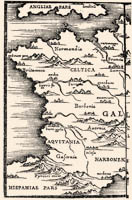 |
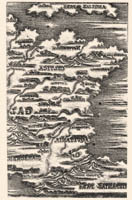 |
Detail of the wood-cut map representing Gallia from Rudimenta cosmographica
(RMNy 50) |
The surviving original wooden block of Gallia (RMNy 50) |


- Maps - Printing types - Illustrations - Coats of Arms -
Title-page borders - Printed notations - Back to the top


PRINTING TYPES
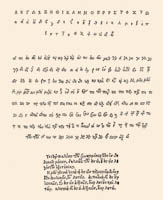 |
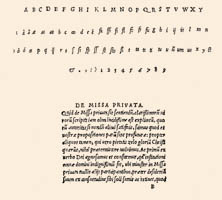 |
Greek types of Honterus’ press |
Italics of Honterus’ press |
|
Ornamental fraktur types of Honterus’ press |


- Maps - Printing types - Illustrations - Coats of Arms -
Title-page borders - Printed notations - Back to the top


ILLUSTRATIONS
|
Images from the Danse
Macabre-series (RMNy 142) |


- Maps - Printing types - Illustrations - Coats of Arms -
Title-page borders - Printed notations - Back to the top


COATS OF ARMS
|
Coats of arms from
Honterus’ prress |


- Maps - Printing types - Illustrations - Coats of Arms -
Title-page borders - Printed notations - Back to the top


TITLE-PAGE BORDERS
|
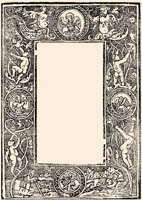 |
Title-page border containing the crest of Brassó |
Title-page border of Novum Testamentum (RMNy 139) |


- Maps - Printing types - Illustrations - Coats of Arms -
Title-page borders - Printed notations - Back to the top


PRINTED NOTATIONS
|
Printed musical notations from Honterus’ press |


- Maps - Printing types - Illustrations - Coats of Arms -
Title-page borders - Printed notations - Back to the top
